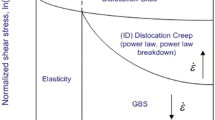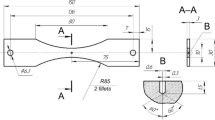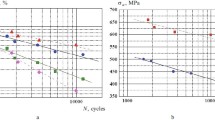Abstract
A model was developed to explain the mechanism of the degradation of fatigue lives caused by the growth of transgranular crack without cavitational damage in spite of the creep-fatigue loading condition for some type 304L stainless steel and 1Cr-Mo-V steel. The model was developed by incorporating the stress relaxation effect during tensile hold time into the pure fatigue crack growth model based on the crack-tip shearing process. In the crack-tip region, the stress relaxation during hold time at the tensile peak stress reduces the maximum stress level but accumulates inelastic strain, which induces creep crack growth during hold time and enhances subsequent fatigue crack growth during subsequent loading by promoting the crack-tip shearing process. The predicted creep-fatigue lives by the model were in good agreement with the actual lives for type 304L stainless steel at 823 and 865 K and for 1Cr-Mo-V rotor steel at 823 K. The model was further expanded to explain the degradation of the life under the conditions of compressive hold cycling for 1Cr-Mo-V and 12Cr-Mo-V steels.
Similar content being viewed by others
References
J. Wareing: in Fatigue at High Temperature, R.P. Skelton, ed., Applied Science Publishers, London, 1983, pp. 135–85.
J.W. Hong, S.W. Nam, and K.-T. Rie: J. Mater. Sci., 1985, vol. 20, pp. 3763–70.
S.W. Nam, Y.C. Yoon, B.G. Choi, J.M. Lee, and J.W. Hong: Metall. Trans. A, 1996, vol. 27A, pp. 1273–81.
J. Weiss and A. Pineau: Metall. Trans. A, 1993, vol. 24A, pp. 2247–61.
R. Neu and H. Sehitoglu: Metall. Trans. A, 1989, vol. 20A, pp. 1755–67.
K.-T. Rie and J. Olfe: Proc. Mechanical Behavior of Materials—VI, Pergamon Press, plc, Headington Hill Hall, Oxford OX3 OBW, UK, 1992, pp. 367–72.
L.A. James: Nucl. Technol., 1972, vol. 16, pp. 521–30.
B. Tomkins and J. Wareing: Mater. Sci., 1977, pp. 414–24.
M. Okazaki, I. Hattori, and T. Koizumi: Metall. Trans. A, 1984, vol. 15A, pp. 1731–39.
Z.G. Wang, C. Laird, and K. Rahka: Mater. Sci. Eng., 1985, vol. 73, pp. 113–29.
J.H. Ryu and S.W. Nam: Proc., 1st Conf. on Mechanical Behavior, The Kor. Inst. Met. & Mater., Seoul, Korea, 1987, p. 33.
S.W. Nam, S.C. Lee, and J.M. Lee: Nucl. Eng. Design, 1995, vol. 153, pp. 213–21.
A. Saxena, R.S. Willains, and T.T. Shih: in Fracture Mechanics: 13th Conf., ASTM STP 770, ASTM, Philadelphia, PA, 1981, pp. 86–99.
P.S. Grover and A. Saxena: Fat. Fract. Eng. Mater. Struct., 1999, vol. 22, pp. 111–22.
N. Adefris, A. Saxena, and D.L. McDowell: Fat. Fract. Eng. Mater. Struct., 1996, vol. 19, pp. 387–99.
J.K. Tien, S.V. Nair, and V.C. Nardone: in Flow and Fracture at Elevated Temperatures, ASM Material Science Seminar, ASM, Materials Park, OH, 1983, pp. 179–213.
R.P. Skelton: in ESIS 15, R.A. Ainsworth and R.P. Skelton, eds., Mechanical Engineering Publication, London, 1993, pp. 191–218.
Y.J. Oh and S.W. Nam: Scipta Metall., 1992, vol. 26, pp. 643–48.
Y.J. Oh and S.W. Nam: J. Mater. Sci., 1992, vol. 27, pp. 2019–25.
J.R. Haigh, R.P. Skelton, and C.E. Richards: Mater. Sci. Eng., 1976, vol. 26, pp. 167–74.
K. Wada, Y. Lino, and M. Suzuki: Low Cycle Fatigue and Life Prediction, ASTM STP 770, ASTM, Philadelphia, PA, 1980, pp. 422–35.
D. Tomkins: Phil. Mag., 1968, vol. 18, pp. 1041–66.
C.E. Jaske: Fat. Eng. Mater. Struct., 1983, vol. 6, p. 159.
C. Laird: Fatigue Crack Propagation, ASTM STP 415, ASTM, Philadelphia, PA, 1967, pp. 131–80.
A. Saxena and S.D. Antolovich: Metall. Trans. A, 1975, vol. 6A, pp. 1809–28.
I.R. Rice: Fatigue Crack Propagation, ASTM STP 415, ASTM, Philadelphia, PA, 1967, pp. 247–311.
J. Morrow: ASTM STP 467, ASTM, Philadelphia, PA, 1970, p. 45.
A. Saxena: Fat. Eng. Mater. Struct., 1981, vol. 3, p. 247.
B.O. Kong, S.C. Lee, and S.W. Nam: J. Kor. Inst. Met. Mater., 1991, vol. 29, pp. 514–21.
J. Wareing and H.G. Vaughan: Met. Sci., 1977, Oct., pp. 439–46.
H. Teranish and A.J. Mcevily: Metall. Trans. A, 1979, vol. 10A, pp. 1806–08.
D.C. Lord and L.F. Coffin, Jr.: Metall. Trans., 1973, vol. 4, pp. 1647–51.
H. Riedel and J.R. Rice: Fracture Mechanics, ASTM STP 700, Philadelphia, PA, 1980, pp. 112–30.
P.S. Maiya and S. Majumdar: Metall. Trans. A, 1977, vol. 8A, pp. 1651–60.
Author information
Authors and Affiliations
Rights and permissions
About this article
Cite this article
Oh, Y.J., Hong, J.H. & Nam, S.W. A model for creep-fatigue interaction in terms of crack-tip stress relaxation. Metall Mater Trans A 31, 1761–1775 (2000). https://doi.org/10.1007/s11661-998-0327-3
Received:
Issue Date:
DOI: https://doi.org/10.1007/s11661-998-0327-3




